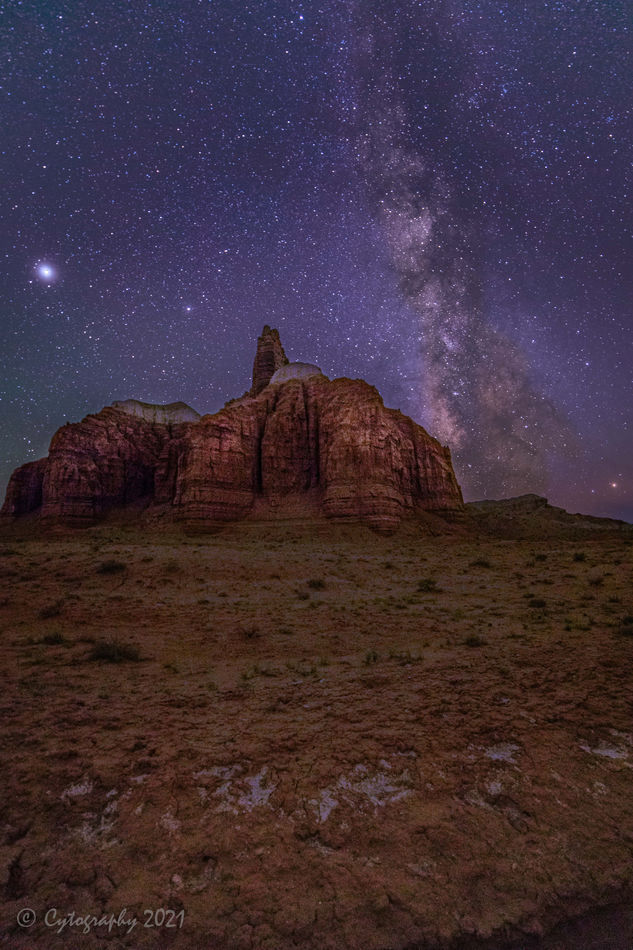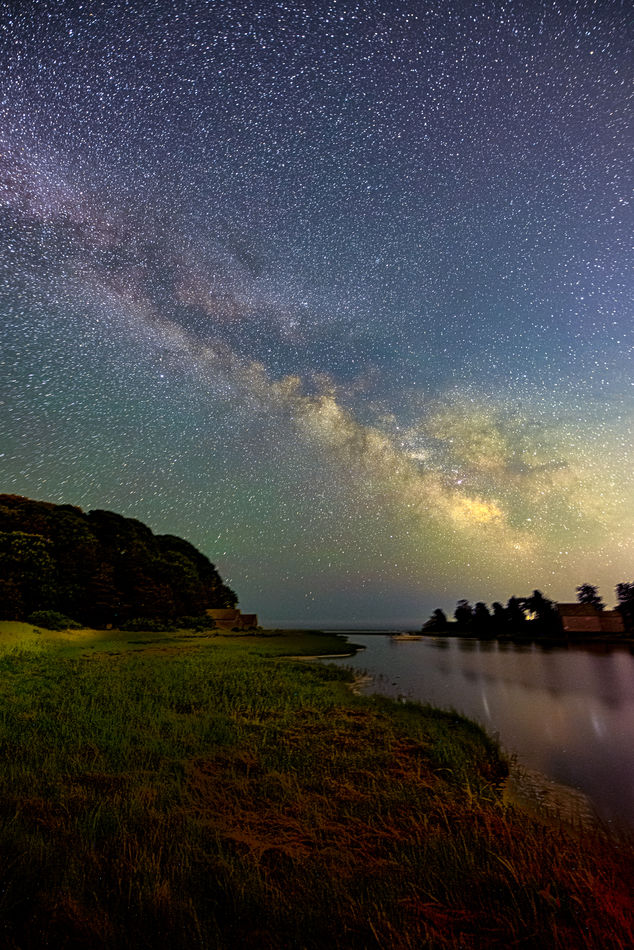Wide angle lens for Milky Way shots
Feb 5, 2022 13:14:36 #
wrk1234
Loc: Russellville, Arkansas
I will be trying to get some good milky way shots this spring and summer. I own a Sigma 24mm f/1.4 lens that I have used for these shots in the past. I have just found that Sigma now has a 20mm f/1.4 lens for sale. The question becomes will I get substantially more with the 20mm lens than I am getting with the 24mm lens?. I don’t mind buying the wider lens IF it means better photos but I sure don’t want to spend the money for minimal differences. If it makes any difference, I am shooting a Canon 5D mark IV.
Feb 5, 2022 13:22:06 #
Feb 5, 2022 14:24:55 #
I bought a Rokinon 14mm for precisely that purpose. It’s f2.8 manual focus and in my humble opinion the best bang for the buck for shooting Milky Way images. (I bough mine used for under $300). Example of a shot with this lens on a 5D Mark IV.

Feb 5, 2022 14:29:51 #
Basil wrote:
I bought a Rokinon 14mm for precisely that purpose. It’s f2.8 manual focus and in my humble opinion the best bang for the buck for shooting Milky Way images. (I bough mine used for under $300).
I'm planning on getting the Rokinon 14mm myself, but as a general ultra-wide as there is too much light pollution around here for astro.
MPB has two of them in excellent condition for $194 and two in like new condition for $204...in Nikon mounts with the AE chip.
Feb 5, 2022 14:46:24 #
larryepage
Loc: North Texas area
wrk1234 wrote:
I will be trying to get some good milky way shots ... (show quote)
The benchmark for night sky shooting is a really good 14-24 mm f/2.8 on a full frame camera. I use a Nikon camera and have used the Nikkor 14-24 f/2.8 for four years for this. Some will say that it has unacceptable distortion. I have not found that to be true in actual use.
If you are shooting individual shots with terrestrial foreground interest, you'll appreciate having 14mm. Stitched panoramas allow for a little more flexibility. If you are using DX camera, 24mm isn't going to be nearly wide enough, although you might be able to make it work with extra steps and effort. 10mm gets close to what you need there. Whatever lens you choose needs to be rectilinear, not a fisheye.
Your camera is important. Typical exposure is 30 seconds or so at ISO 5000. You really can't go beyond that. 20 seconds would ordinarily be the limit for a 24mm lens (Rule of 500).
Feb 6, 2022 06:21:46 #
Basil wrote:
I bought a Rokinon 14mm for precisely that purpose. It’s f2.8 manual focus and in my humble opinion the best bang for the buck for shooting Milky Way images. (I bough mine used for under $300). Example of a shot with this lens on a 5D Mark IV.
Very nice and informative.
Feb 6, 2022 06:41:22 #
Basil wrote:
I bought a Rokinon 14mm for precisely that purpose. It’s f2.8 manual focus and in my humble opinion the best bang for the buck for shooting Milky Way images. (I bough mine used for under $300). Example of a shot with this lens on a 5D Mark IV.
I use a Sigma 14-24 f/2.8 on a Nikon D750. Typically I take 8-10 shots about 10 seconds each then merge them using Sequator. This is from Salt Pond in Eastham on Cape Code, Mass.
Feb 6, 2022 07:24:48 #
billnikon
Loc: Pennsylvania/Ohio/Florida/Maui/Oregon/Vermont
wrk1234 wrote:
I will be trying to get some good milky way shots ... (show quote)
Even wider would be nicer.
Feb 6, 2022 09:03:08 #
wrk1234 wrote:
I will be trying to get some good milky way shots ... (show quote)
Think about what you ask. The stars in the MilkyWay are several million miles away. Your dilemma deals with a difference of 4 mms? See for yourself.. Set your camera on a tripod and make photographs of something at least 1 mile away with each lens and compare the different photos. We shot the M/W in Rocky Mtn. N P a few years ago and nobody has ever commented on the lens I used. In your situation the speed of the lens is far more important that its F/L. We had 5 shooters all using a Canon 24mm f/1.4. M/W shots critically need speed.
Feb 6, 2022 10:15:02 #
Basil wrote:
I bought a Rokinon 14mm for precisely that purpose. It’s f2.8 manual focus and in my humble opinion the best bang for the buck for shooting Milky Way images. (I bough mine used for under $300). Example of a shot with this lens on a 5D Mark IV.
I have the same lens and love it. Really impressive the sharpness of an off brand lens.
Feb 6, 2022 10:48:09 #
Sidwalkastronomy
Loc: New Jersey Shore
I have the Tamron 10-24 mm but it's on a 1.6 crop sensor camera that I'm going to mount on my celestron AVX gem mount
Feb 6, 2022 10:48:16 #
larryepage
Loc: North Texas area
The focal length for night sky photography is only secondarily based on the field of view. I've seen some reasonably decent work done with two-dimensional panoramas using a
normal" lens. The primary concern is avoiding star trails (unless you are willing to invest in a tracker). The longest exposure is determined by the "Rule of 500" for full frame cameras up to 20 or 24 Mp. For higher resolution cameras, like the D810 or D850, following a Rule or 300 (or even a little less) will produce better results.
The other issue, of course, is how the celestial components of the image move with respect to the ground as exposures get longer (slower lens, constraint to a lower ISO) or as more exposures are required (longer focal length lens). Capturing the full arc of the Milky Way at 14mm with a full frame camera at a reasonable height in the sky typically requires about 10 exposures at 14mm with about 50% overlap, which is the standard for reliable stitching. This requires between 6 and 10 minutes with 30 second exposures, especially if one or two of the exposures need to be redone, which is not uncommon. That's long enough for noticeable movement between the first and last exposure, since the earth rotates at a rate of 15 degrees per hour. That's one degree every 4 minutes, or about 2.5 degrees over a 10 minute period. Single images will be extremely limited at 24mm, even on a full frame camera.
So yes...small changes in the focal length used will make significant changes to the process required to capture your images. They will not make it impossible to capture the image, but they make it more difficult. In this discussion, we do not know what camera the OP is using. We don't know whether it is full frame, half frame, or something smaller. And we don't know the make or model. I will tell you that both will make a difference in what can actually be accomplished. I have a D300 that I still love to shoot occasionally. But it would be impossible to capture an identifiable Milky Way image with it, no matter what lens I used. It might be possible to do something with the use of a tracker, but I honestly don't know how it would work with the 3 or 4 minute exposures that would be required.
normal" lens. The primary concern is avoiding star trails (unless you are willing to invest in a tracker). The longest exposure is determined by the "Rule of 500" for full frame cameras up to 20 or 24 Mp. For higher resolution cameras, like the D810 or D850, following a Rule or 300 (or even a little less) will produce better results.
The other issue, of course, is how the celestial components of the image move with respect to the ground as exposures get longer (slower lens, constraint to a lower ISO) or as more exposures are required (longer focal length lens). Capturing the full arc of the Milky Way at 14mm with a full frame camera at a reasonable height in the sky typically requires about 10 exposures at 14mm with about 50% overlap, which is the standard for reliable stitching. This requires between 6 and 10 minutes with 30 second exposures, especially if one or two of the exposures need to be redone, which is not uncommon. That's long enough for noticeable movement between the first and last exposure, since the earth rotates at a rate of 15 degrees per hour. That's one degree every 4 minutes, or about 2.5 degrees over a 10 minute period. Single images will be extremely limited at 24mm, even on a full frame camera.
So yes...small changes in the focal length used will make significant changes to the process required to capture your images. They will not make it impossible to capture the image, but they make it more difficult. In this discussion, we do not know what camera the OP is using. We don't know whether it is full frame, half frame, or something smaller. And we don't know the make or model. I will tell you that both will make a difference in what can actually be accomplished. I have a D300 that I still love to shoot occasionally. But it would be impossible to capture an identifiable Milky Way image with it, no matter what lens I used. It might be possible to do something with the use of a tracker, but I honestly don't know how it would work with the 3 or 4 minute exposures that would be required.
Feb 6, 2022 11:06:59 #
tcthome
Loc: NJ
Basil wrote:
I bought a Rokinon 14mm for precisely that purpose. It’s f2.8 manual focus and in my humble opinion the best bang for the buck for shooting Milky Way images. (I bough mine used for under $300). Example of a shot with this lens on a 5D Mark IV.
Nice photo!
Feb 6, 2022 12:14:57 #
ahudina
Loc: Browns Point, WA
wrk1234 wrote:
I will be trying to get some good milky way shots ... (show quote)
I would rent the 20mm sigma 1.4 first. I was shooting with a Nikon D 850. I had one and found the coma unacceptable and sold it. Read all the reviews first and use the rental to see if the image is acceptable to you. I use a sigma Art 14-24 and love it. Also have a sigma art 14 1.8 and needs a stop down to assist with coma. Cheers.
Feb 6, 2022 13:03:29 #
Basil wrote:
I bought a Rokinon 14mm for precisely that purpose. It’s f2.8 manual focus and in my humble opinion the best bang for the buck for shooting Milky Way images. (I bough mine used for under $300). Example of a shot with this lens on a 5D Mark IV.
I have taken pics that are really good, but I took them at Mount Paloma’s observatory. You really nailed this shot.
If you want to reply, then register here. Registration is free and your account is created instantly, so you can post right away.






